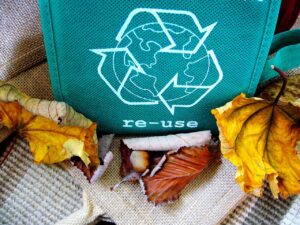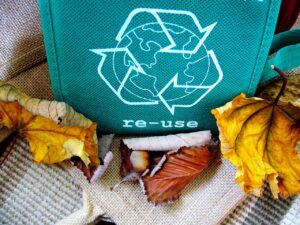Shifting from recycling to re-looping to fast-track the circular economy
 9 Juni 2023
9 Juni 2023
As the world continues to transition from a linear to an increasingly circular business model it is time to update our perspective on recycling. By definition recycling entails converting materials from used products into new materials for other products.
Historically this has been lower value products. Now we have the technological capacity to re-loop used products into high-quality materials and turn them into high-value products. In so doing we would simultaneously reduce waste and our reliance on virgin resources.
With this in mind, and given that plastic packaging constitutes the largest application for plastics with a 41% share of all processed plastics, equating to 106 million tons in 2018 (according to the European Investment Bank), re-evaluating our approach to recycling plastic packaging could help us fast-track the circular economy.
To achieve this we need to focus our attention on turning used products back into equal value products. In other words re-looping plastic packaging rather than just recycling it into commodity resins.
This is not a play on words: it’s a fundamental shift in mindset.
Bearing mind that whilst brand owners and retailers are increasingly pressing for high-quality recyclates to meet their sustainability goals, there is a disconnect between what they want and what they are putting onto the market. And it is this disconnect I want to address.
KPMG recently flagged up a rather obvious fact that insufficient plastic waste volumes are reaching sorting. They pointed to a lack of pre-sorting as the main cause. Whilst it is certainly true that we need to increase recovery rates, boosting the pre-sorting infrastructure alone will achieve very little.
What we need is to go back to the the plastic packaging design drawing board to really make a difference. A paradigm shift in the current design guidelines for circular packaging has the potential to transform recycling rates. The guideline alterations I have in mind would enable us to re-loop rather than recycle, thereby reducing waste, our carbon footprint and our drain on valuable resources.
So what would this entail?
With re-looping in mind it is vital products are designed to be re-used in the same or equivalent products. Furthermore this should occur using existing recycling technologies located in the markets where the products are sold. We need a greater drive toward closing loop cycles for products as this will address the uncontrolled contamination challenge and therefore enhance circular destinations.
Products should be designed for multiple re-looping in every way. This means optimising both the stabilising and processing additives to comply with the EU approved list (10/2011 regulations) for materials and additives used in food contact. Mono-materials or mixed materials of the same type facilitate recyclers’ work as they don’t downgrade the properties of the recycled plastic and can be sorted and subsequently processed as if it were a single material.
I have previously spoken about the potential value of pigments, using colours to assist rather than hinder recycling. Ultimately colours interfere with the mechanical recycling process hence un-pigmented polymers have the highest recycling value and the widest variety of end uses. If colours were used for sorting packaging categories rather than for branding purposes, recycling as we know it would be simplified almost overnight.

Let’s imagine a world where all food is contained in clear or white plastic packaging to ensure safe re-looping from food-grade applications. This would leave pastel colours for household goods and cleaning products.
All toxic products could be contained in packaging pigmented with carbon black or NIR detectable black to ensure exclusion from food applications during recycling and re-looping.
Every element of a pack must come under scrutiny. The adhesives used for the labels should be designed for easy removal during recycling to ensure no adhesives remain on the packaging with all ingredients selected from the 10/2011 approved list.The inks should be selected to comply with EUPIA guidelines to ensure freedom from potentially hazardous substances.
Direct printing of inks onto plastics should be avoided unless their removal can be assured according to approved recycling/re-looping protocols to ascertain inks can be removed as particulates and not by washing/dissolution into water. The supporting strategies to re-loop products into new high-quality material and applications will need to be well thought-through and robust.
Starting with improved product design and decoration to ensure re-looping simplicity, followed by sorting of packaging by NIR/VIS/AI/markers. In-mould labels (IMLs) should be removable, there must be an ink removal washing stage and a flake sorting sequence prior to re-looping processes and decontamination for volatiles and other molecules that have migration potential.
Likewise, high-performance traceability of inputs and blending for uniformity and consistency will be key to test materials and products and avoid crossover of resins and grades.
Contrary to popular belief, adopting the re-looping approach for packaging design does not mean brand owners and retailers will have to relinquish the cohesive visual language they rely on to reflect their brand values, positioning or target market. It will mean, however, extending the design requirements of their packaging and taking the key facets mentioned above into account.
If we can embrace the notion of re-looping these upgraded packaging design guidelines will help brands navigate what currently appears to be a complex recycling conundrum.
One thing is sure, we can no longer expect that recyclers will somehow solve all the problems. We need to take a collaborative approach and this does mean universally adopting revised packaging design guidelines that boost the re-looping concept. Packaging designers, brand owners, manufacturers, marketers and recyclers can’t afford to work in silos. Neither can they afford to sit back and wait for some shiny new tech to solve all the issues.
Re-looping is not a fancy new buzz word: it is an urgent pointer to the way the world must approach everything produced. Failing to do so risks jeopardising our efforts to keep our carbon footprint within a liveable range. If we shun changing the way we design packaging voluntarily, we may have to learn how to adapt to far more serious changes around the world.
The post Shifting from recycling to re-looping to fast-track the circular economy appeared first on Sustainability Times.
